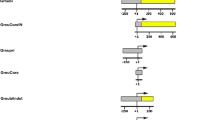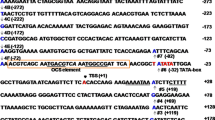Abstract
The Me1 gene of the dicot Flaveria bidentis encodes NADP malic enzyme, which catalyses the decarboxylation reaction of C4 photosynthesis in bundle sheath cells. We have previously shown that the 3′ non-coding region (Me1 3′) controls quantitative expression of the gene. We wondered whether Me1 3′ can increase expression when combined with heterologous promoters. We tested a highly expressed, constitutive promoter, the S4 promoter from subterranean clover stunt virus, and a highly expressed, leaf-specific promoter, the light-harvesting chlorophyll a/b-binding protein gene 3 (Lhcb3) promoter of Arabidopsis thaliana. Promoter-3′-end combinations were tested in transgenic C4 Flaveria plants and C3 tobacco. We found that Me1 3′ increased expression of the gusA reporter gene several-fold in leaves of both species in combination with either of the promoters. In both cases Me1 3′ does not alter the expression pattern for either promoter. We conclude that Me1 3′ can be used as a transcription terminator to increase transgene expression in C3 dicot plants.
Similar content being viewed by others
References
Ali, S. and Taylor, W.C. 2001. Quantitative regulation of the Flaveria Mel gene is controlled by the 3′-untranslated region and sequences near the amino terminus. Plant Mol. Biol. 46: 251–261.
An, G. 1987a. Binary Ti vectors for plant transformation and promoter analysis. Meth. Enzymol. 153: 292–305.
An, G. 1987b. Integrated regulation of the photosynthetic gene family from Arabidopsis thaliana in transformed tobacco cells. Mol. Gen. Genet. 207: 210–216.
Boevink, P. 1995. Molecular Characterisation of Subterranean Clover Stunt Virus. Ph.D. Dissertation, Australian National University, Canberra, ACT, Australia.
Chen, R., Silver, D.L. and de Bruijn, E.J. 1998. Nodule parenchyma-specific expression of the Sesbania rostrata early nodulation gene SrEnod2 is mediated by 3′-untranslated region. Plant Cell 10: 1585–1602.
Chitty, J.A., Furbank, R.T., Marshall, J.S., Chen, Z. and Taylor, W.C. 1994. Genetic transformation of the C4 plant, Flaveria bidentis. Plant J. 6: 949–956.
Daniel, S.G. and Becker, W.M. 1995. Transgenic analysis of the 5′ and 3′ flanking regions of the NADH-dependent hydroxypyruvate reductase gene from Cucumis sativus L. Plant Mol. Biol. 28: 821–836.
Dean, C., Favreau, M., Bond-Nutter, D., Bedbrook, J. and Dunsmuir, P. 1989. Sequences downstream of translation start regulate quantitative expression of two petunia rbcS genes. Plant Cell 1: 201–208.
Deitrich, R.A., Radke, S.E. and Harada, J.J. 1992. Downstream DNA sequences are required to activate a gene expressed in the root cortex of embryos and seedlings. Plant Cell 4: 1371–1382.
Dengler, N.G. and Taylor, W.C. 2000. Developmental aspects of C4 photosynthesis. In: R.C. Leegood, T.D. Sharkey and S. von Caemmerer (Eds.) Photosynthesis: Physiology and Metabolism, Kluwer Academic Publishers, Dordrecht, Netherlands, pp. 471–495.
Fu, H., Kim, S.Y. and Park, W.D. 1995a. High-level tuber expression and sucrose inducibility of a potato Sus4 sucrose synthase gene requires 5′ and 3′ flanking sequences and the leader intron. Plant Cell 7: 1387–1394.
Fu, H., Kim, S.Y. and Park, W.D. 1995b. A potato Sus3 sucrose synthase gene contains a context-dependent 3′ element and a leader intron with both positive and negative tissue specific effects. Plant Cell 7: 1395–1403.
Janssen, B.J. and Gardner, R.C. 1989. Localized transient expression of GUS in leaf dics following cocultivation with Agrobac-terium. Plant Mol. Biol. 14: 61–72.
Jefferson, R. 1987. Assaying chimeric genes in plants: the GUS gene fusion system. Plant Mol. Biol. Rep. 5: 387–405.
Larkin, J.C., Oppenheimer, D.G., Pollock. S. and Marks, M.D. 1993. Arabidopsis GLABROUS1 gene requires downstream sequences for function. Plant Cell 5: 1739–1748.
Marshall, J.S., Stubbs, J.D. and Taylor, W.C. 1996. Two genes encode highly similar chloroplastic NADP-malic enzymes in Flaveria: implications for the evolution of C4 photosynthesis. Plant Physiol. 111: 1251–1261.
Marshall, J.S., Stubbs, J.D., Chitty, J.A., Surin, B. and Taylor, W.C. 1997. Expression of the C4 Me1 gene from Flaveria bidentis requires an interaction between 5′ and 3′ sequences. Plant Cell 9: 1515–1525.
Rogers, S.O. and Bendich, A.J. 1988. Extraction of DNA from plant tissues. In: S.B. Gelvin and R.A. Schilperoort (Eds.) Plant Molecular Biology Manual, Kluwer Academic Publishers, Dordrecht, Netherlands, pp. A6: 1-10.
Rosche, E., Chitty, J.A., Westhoff, P. and Taylor, W.C. 1998. Analysis of promoter activity for the gene encoding pyruvate, orthophosphate dikinase in stably transformed C4 Flaveria.Plant Physiol. 117: 821–829.
Sambrook, J., Fritsch, E.F. and Maniatis, T. 1989. Molecular Cloning: A Laboratory Manual, 2nd ed. Cold Spring Harbor Laboratory Press, Plainview, NY.
Sheen, J. 1999. C4 gene expression. Annu. Rev. Plant Physiol. Plant Mol. Biol. 50: 187–217.
Surin, B., Boevink, P., Keese, P., Chu, P., Larkin, P., Llewellyn, D., Kahn, R., Ellacott, G. and Waterhouse, P. 1998. A suite of promoters and terminators for plant biotechnology. In: P.J. Larkin (Ed.) Agricultural Biotechnology: Laboratory, Field and Market. Proceedings of the Fourth Asia-Pacific Conference on Agricultural Biotechnology, Darwin, 13-16 July 1998, UTC Publishing, Canberra, pp. 121–122.
Thornburg, R.W., An, G., Cleaveland, T.E., Johnson, R. and Ryan, C.A. 1987. Wound-inducible expression of a potato inhibitor II-chloramphenicol acetyltransferase gene fusion in transgenic potato plants. Proc. Natl. Acad. Sci. USA 84: 744–748.
Author information
Authors and Affiliations
Rights and permissions
About this article
Cite this article
Ali, S., Taylor, W.C. The 3′ non-coding region of a C4 photosynthesis gene increases transgene expression when combined with heterologous promoters. Plant Mol Biol 46, 325–334 (2001). https://doi.org/10.1023/A:1010669204137
Issue Date:
DOI: https://doi.org/10.1023/A:1010669204137




